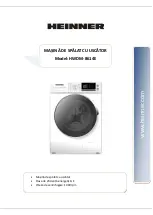
Page 5
The exhaust duct should end with an exhaust hood with a swing-out flap to prevent back-draughts and
access for wildlife
(see
Accessories
)
. Never use an exhaust hood with a magnetic flap. The hood
should have at least 300mm (12”) clearance between the bottom of the hood and the ground or other
obstruction. The hood opening should point down. Never install a screen over the exhaust outlet.
When possible, do not exhaust the dryer directly into a basement window well in order to avoid a lint
build-up. Do not exhaust under a building. If exhaust ductwork must run through an unheated area, the
duct should be insulated and slope slightly down towards the exhaust hood to reduce condensation and
lint build-up.
If an existing exhaust system is to be used with your new machine, you must ensure:
– The exhaust system meets all local and national regulations
– That plastic flexible duct is not used.
– To completely inspect and clean all lint accumulation from the duct interior.
– The duct is not kinked or crushed which could restrict airflow.
– The exhaust hood flap opens and closes freely.
If multiple units are exhausted into a common duct:
1. An exhaust cross-section area of 78cm
2
(12.6”
2
) is required per dryer. This will allow for free air
movement should all dryers be operated simultaneously.
2. A power exhaust may be used on multiple installations.
3. Ducts larger than 100mm (4”) diameter can result in increased lint accumulation. Such lint
accumulation should be cleaned regularly.
4. Exhaust ducting should be kept as short and direct as possible.
The operating pressure in the exhaust system must not exceed 23mm (0.92”) water gauge, or be less
than 0. This can be measured with the dryer(s) operating, by inserting a manometer connection at the
point where the exhaust duct connects to the dryer (a no-heat part of a cycle should be used, without
clothes load and with a clean lint filter).
Inspect and clean the interior of the dryer exhaust system at least twice a year. Disconnect from the
electricity supply prior to cleaning. Check the gas supply connection any time the machine is moved.
Frequently check to be sure the exhaust hood flap opens and closes freely.
7. Electrical connection
WARNING:
This is a 3-wire appliance which must be earthed.
The gas dryer/washer is fitted with an electrical supply cord and plug. It
should be connected to an electricity supply socket at the voltage shown
on the dataplate. The minimum supply fuse capacity should be 10A. The
appliance must be positioned so that the plug is accessible. If the fitted
plug is not used, the electrical connection must be carried out by a com-
petent electrician in accordance with local or national wiring regulations.
Do not use extension lead assemblies on commercial installations.
If the supply cord is damaged, it must be replaced with a specially
terminated cord by an authorized service agent or a similarly qualified
person in order to avoid a hazard.
The electric dryer/washer is supplied without an electric cord and plug. It must be connected to a single-
phase electricity supply at the voltage shown on the dataplate, by a suitable fixed wiring installation in
accordance with local and national wiring regulations. A 3-wire circular cord of minimum conductor size
2.5mm
2
cross-section area should be used. A 30A supply fuse should be used, and a switch with a
minimum contact separation of 3mm in both poles must be incorporated into the fixed wiring for machine
disconnection. A cord clamp bush is provided with the machine, and should be tightened on completion
of wiring. The electrical mains terminals are located behind the small rear access panel at the top of the
dryer, and connections should be made as shown in the figure above. Remember to replace the terminal
access panel.




























